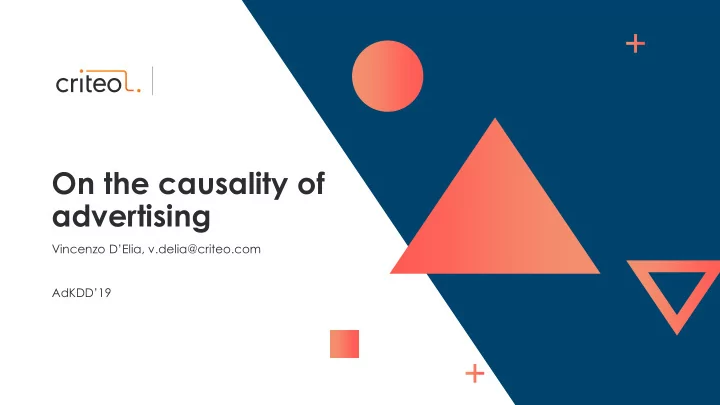

On the causality of advertising Vincenzo D’Elia , v.delia@criteo.com AdKDD’1 9
Advertisers Ad Server/SSPs Demand side Platform Ad Exchange 2
from Criteo Q2 2019 Earnings report
4 from Criteo Q2 2019 Earnings report
Demand side: Advertisers • Integration • Set a bid (CPC, CPA) and/or a budget • Set an objective (views, clicks, conversions, … ) Supply side: Ad exchanges • Criteo Integrates with SSPs • We participate in real time on a CPM basis 5
Demand side: Advertisers • “Second price” property: higher CPA → higher payment → higher volume Supply side: Ad exchanges • Second price auctions (with/without reserve prices, dynamic floors, etc.) • First price auctions • Header bidding (multiple sub- auctions resolved by a single “meta - auction”) • … 6
• bid ∝ CPA * P(A|Display, User, Context info) • We show and track ads 7 More on https://www.criteo.com/retargeting-ad-examples/
Budget management Budget How many allocation Actions? What is the revenue of Align marginal ROIs the Ad campaign? What should we predict? 8
Advertiser’s dashboard # users Organic # visits Marketing channel X: Budget X$ # conversions Marketing # actions channel Y: Budget Y$ 9
The attribution problem users visits # users Organic conversions actions # visits users Marketing Attribution visits channel X: algorithm conversions Budget X$ actions # conversions users Marketing visits # actions channel Y: conversions Budget Y$ actions 10
Advertisers’ attribution models – rule based Other rules, based on • Position (i.e. first and last clicks get 40% each, the rest is uniform) • Matching to other events (e.g. add to cart) 11
Advertisers’ attribution models – algorithmic Incremental value effect • Probability of conversion as a function of ad exposure • Use the model to compute incremental value of each ad. • Game theory • Shapley values (assign credit to individual channels who cooperate to • generate a conversion) Multiple payment schemes proposed • 12 Cf..Sigal et al, 2019.
What are the models for an attribution- aware bidder? Cf..Diemert et al, 2017.
Advertiser’s dashboard # users Organic # visits Marketing channel X: Budget X$ # conversions Marketing # actions channel Y: Budget Y$ 14
Use a control population! # users Organic Control 20% # visits ignore first days Marketing channel X: Budget X$ # conversions Control 20% ignore first days Marketing # actions channel Y: Budget Y$ 15
Incrementality testing for a DSP Test Control $ $ $ $ $ $ It is client-wise • Test users get the normal treatment • $ $ $ $ For a Control user, every time we • would show an ad for the client under iABT $ We log all information • $ We participate with another • $ client 16
Uplift measurement - exposed Test Control $ $ $ $ $ $ Exposed Users who had seen an ad vs users who would have seen an ad (for a specific $ client) $ $ $ It is a It a counterfactu tual l mea easurem ement. $ Exposed $ $ 𝐕𝐪𝐦𝐣𝐠𝐮 = 𝐓𝐛𝐦𝐟𝐭 𝐔𝐟𝐭𝐮 − 𝐓𝐛𝐦𝐟𝐭 𝐃𝐩𝐨𝐮𝐬𝐩𝐦 𝐓𝐛𝐦𝐟𝐭 𝐃𝐩𝐨𝐮𝐬𝐩𝐦 Computed on exposed population (!?!) 17
Uplift measurement – Intent to treat Test Control $ $ $ $ $ $ Int Intent to tr treat We consider all users which could have been treated (e.g. all retargetable $ users) $ $ $ 𝐕𝐪𝐦𝐣𝐠𝐮 = 𝐓𝐛𝐦𝐟𝐭 𝐔𝐟𝐭𝐮 − 𝐓𝐛𝐦𝐟𝐭 𝐃𝐩𝐨𝐮𝐬𝐩𝐦 $ 𝐓𝐛𝐦𝐟𝐭 𝐃𝐩𝐨𝐮𝐬𝐩𝐦 $ Computed on retargetable users $ 18
Uplift measurement – Ghost population Test Control $ $ $ $ $ $ Ghost popula latio ion subset of users that we see on ad exchanges, for which we participate (or $ would participate) for that client $ $ $ Ghost population 𝐕𝐪𝐦𝐣𝐠𝐮 = 𝐓𝐛𝐦𝐟𝐭 𝐔𝐟𝐭𝐮 − 𝐓𝐛𝐦𝐟𝐭 𝐃𝐩𝐨𝐮𝐬𝐩𝐦 $ 𝐓𝐛𝐦𝐟𝐭 𝐃𝐩𝐨𝐮𝐬𝐩𝐦 $ Computed on ghost population $ 19
Approximating control-exposed Test Control $ $ $ $ $ $ Predic icted “Ghost” Ads: use simulated auctions on the ad exchange. $ $ Use it both on test and control to predict $ $ exposed users. predicted $ “Ghost” ads “Ghost” exposed: assume sales in Ghost not $ $ exposed are the same in Test and Control. 20
Beware of filters! The bid bidder chang nges th the sta tatus of f us users rs The e probabil ilit ity that at we e par artic icip ipate for a a client in n iABT is no not th the same be between test and nd control 21
Transparency • Share raw data • All experiences and measurement must be reproducible by both Work with Interpretability clients Who are the incremental buyers? • Where do I generate a new sale? • How effective is web inventory wrt app • inventory? 22
Budget management - bis iABT are expensive • iROI very noisy • What is the revenue of the Ad Measure average iROI is ok • campaign? Measuring marginal iROI much • What should we predict? more challenging Measurement is challenging for small • advertisers How many Actions? 23
How does an incremental attribution system look like?
References Garrett Johnson, Randal A. Lewis and Elmar Nubbemeyer, 2017. Ghost Ads: Improving the Economics of Measuring Online Ad Effectiveness. Simon Business School Working Paper No. FR 15-21. Eustache Diemert, Julien Meynet, Pierre Galland, Damien Lefortier, 2017. Attribution Modeling Increases Efficiency of Bidding in Display Advertising. AdKDD TargetAd workshop at KDD’17. https://arxiv.org/abs/1707.06409v2 Randall A. Lewis and Jeffrey Wong, 2018. Incrementality Bidding & Attribution, 2018. Available at SSRN: https://ssrn.com/abstract=3129350. Raghav Singal, Omar Besbes, Antoine Desir, Vineet Goyal, and Garud Iyengar, 2019. Shapley Meets Uniform: An Axiomatic Framework for Attribution in Online Advertising. Proceedings of the 2019World WideWeb Conference ( WWW ’19 ). https://doi.org/10.1145/3308558.3313731 25
Thank you
Recommend
More recommend